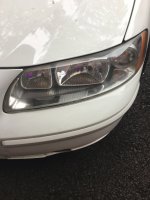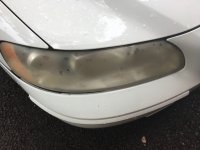John Broomall
Member
- Joined
- Jul 26, 2013
- Messages
- 48
The polycarbonate headlight covers on my wife's Volvo had gotten really bad so I decided to try polishing them out with my RO 90. Because they were so cloudy I started with a 600 grit rather than the usual 1500 and then went 800, 1000, 1500, 3000, followed by polishing compound. Sander speed was set on 3. It took about 20 minutes per lens. I think the before and after photos tell the tale pretty well.


